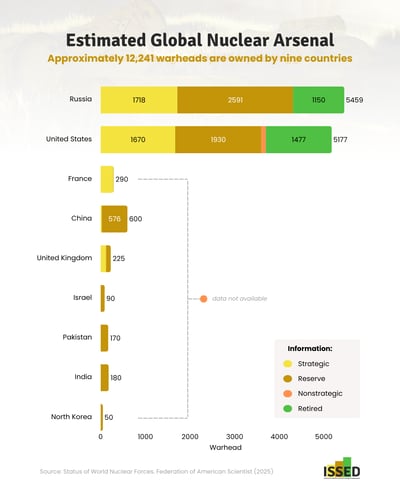Estimated Global Nuclear Weapons Count in 2025
INFOGRAPHICS
Rizqa Ridajani
7/17/2025
The Federation of American Scientists (FAS) estimates that by 2025, nine countries in the world will have around 12,241 nuclear warheads. Two superpowers, Russia and the United States, dominate this possession. Together, they control 87% of the world's total nuclear weapons, each with more than 5,000 units. Meanwhile, the remaining 13% is owned by seven other countries, namely France, China, the United Kingdom, India, Pakistan, Israel, and North Korea. Although their numbers are much smaller, these countries still play a role in maintaining global power and balance.
In general, these nuclear weapons are divided into several main categories. The strategic category refers to warheads that have been installed in long-range launch systems, such as intercontinental missiles or bomber bases, and are ready for use in long-range scenarios. Non-strategic refers to warheads installed in short-range weapon systems. Reserves are warheads that have not been deployed but remain active and ready for use. Meanwhile, the retired category includes warheads that are no longer actively used but have not been dismantled, and thus remain on the total inventory list.
Of the total 12,241 units, 9,614 weapons are still listed as active in military warehouses, with approximately 3,812 of them already operational. Russia has the largest stockpile at 5,459 units, followed by the United States with 5,177 units. Of the total, 2,627 weapons have been categorized as weapons that have been actively decommissioned but not yet dismantled.
This information is sufficient to show that although the total number of warheads has decreased significantly compared to the Cold War era (around 70,300 units in 1986), the world's nuclear power potential remains very large. The reduction in numbers primarily occurred during the 1990s. However, in recent decades, the pace of reduction has slowed, and some countries have even increased their stockpiles. Among these countries are China, India, Pakistan, North Korea, Russia, and the United Kingdom. Meanwhile, only the United States has continued to gradually reduce its stockpile.
The number of warheads in active military stockpiles is now increasing again. These weapons are not merely numbers but are part of defense strategies and global power dynamics. Furthermore, most nuclear-armed states are not fully transparent about the actual data they possess, making estimates like those conducted by the FAS crucial in mapping the dynamics of international security.


